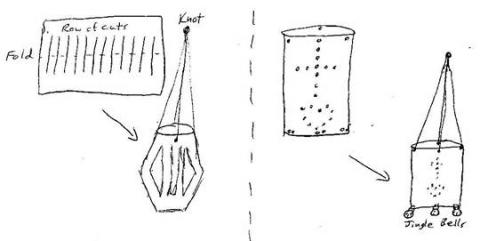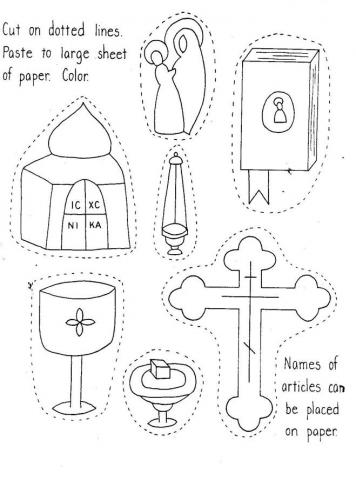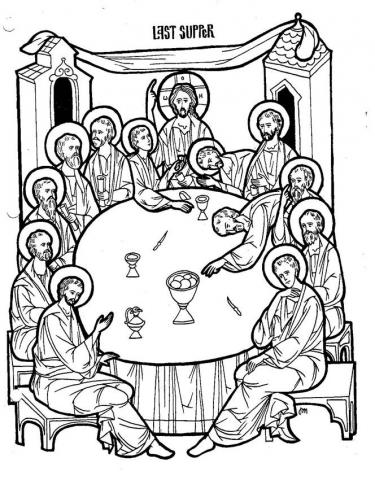Divine Liturgy
DIVINE LITURGY
Objectives:
- Children should know the names of the common objects and people that are a part of the liturgy.
- Children should be familiar with the various parts of the liturgy and their purpose.
Possible Lesson Plan:
- Open with prayer.
- Review with the children the story of the Last Supper in the Children’s Bible. Use the icon for your picture. Who’s sitting at the table? What are they eating? As you tell the story, sit around a table and give the children a piece of bread and a cup of grape juice. Explain that Holy Communion was begun at the Last Supper.
- Have the children repeat until they can say correctly “divine liturgy”. Explain that this is the special service that we have to worship God.
- Review the parts of the liturgy; children should be able to chime in with answers as they recognize the things they have heard and sung for years:
- Litany: Here we pray for the whole world. Who else do we pray for? (travelers, prisoners, leaders of our country, bishops, priests, deacons, rain and sun, food to eat, and we especially remember Mary the Theotokos) What do we respond? (Lord have mercy. Grant it, O Lord.)
- Hymns of worship: 1st and 2nd antiphons, troparia and kontakia, Trisagion -- review these words. Try singing the antiphons we use each Sunday.
- Epistle and Gospel: Here we hear God’s word from the Bible. God speaks to us from His special book, the Gospel Book, which is kept on the altar table. The priest carries out the Gospel and tells us to pay attention to God’s word.
- Cherubic Hymn: God makes us His special guests, along with the seraphim and cherubim, His angels in heaven. The priest uses incense as he prays, reminding us that the prayers go up to God the same way the smoke rises. The discos holds the holy bread and the chalice the communion wine. The tabernacle on the altar holds communion for those who are sick and cannot come to church. The priest carries the chalice and discos in the Great Entrance, while praying for us all!
- Creed: We all recite the creed –review the writing of the creed by the Fathers of the Church in Nicaea under Constantine the Great.
- Preparation for Communion: Review the story of the Last Supper. Here the priest prays for the bread and wine to become the true body and blood of Jesus. We say “Amen” and bow to the altar.
- The Megalynarion: We honor Mary the Theotokos with a special hymn.
- The Lord’s Prayer: Can we say it together? Jesus gave us this prayer himself.
- Holy Communion: Review crossing the arms, opening the mouth, kissing the chalice. Have the children practice this.
- Benediction: The priest blesses us and dismisses us. We all kiss the Cross.
- Take a “field trip” to the sanctuary with a deacon or priest. Look inside the altar and see the tabernacle, the diskos, the chalice, the gospel, the censer, the cross, and the icons.
 Craft idea: Color and cut out the pictures of the altar furnishings. Glue them on a piece of construction paper as if it were a table; label them. Or make a “censer” – either a paper lantern of gold construction or wrapping paper hanging from string or yarn or a metal censer (that can actually hold a candle or incense). Take a 16-ounce tin can for each child. Remove one end. For smaller children, decorate with rick-rack or puffy paint or stickers. Punch holes with an awl at the top and hang with yarn or string (or metal chains from the hardware store. You can even poke some holes near the bottom and use pipe cleaners to attach small jingle bells. For a more difficult punched pattern, fill with water the night before class and freeze solid. At class time, remove from freezer. Give the children each a large nail and a hammer and let them punch a pattern (e.g. cross) in the side of the can. Run it under warm water just long enough to pour out the ice and dry. Finish as before. Too hard, but still want it to be of metal so it can be used for a candle or even incense? Use a foil pot pie pan, decorate as desired even punching holes, or etching pattern with a skewer, or decorating with markers, then use wire or pipe cleaners to attach the bells and hangers.
Craft idea: Color and cut out the pictures of the altar furnishings. Glue them on a piece of construction paper as if it were a table; label them. Or make a “censer” – either a paper lantern of gold construction or wrapping paper hanging from string or yarn or a metal censer (that can actually hold a candle or incense). Take a 16-ounce tin can for each child. Remove one end. For smaller children, decorate with rick-rack or puffy paint or stickers. Punch holes with an awl at the top and hang with yarn or string (or metal chains from the hardware store. You can even poke some holes near the bottom and use pipe cleaners to attach small jingle bells. For a more difficult punched pattern, fill with water the night before class and freeze solid. At class time, remove from freezer. Give the children each a large nail and a hammer and let them punch a pattern (e.g. cross) in the side of the can. Run it under warm water just long enough to pour out the ice and dry. Finish as before. Too hard, but still want it to be of metal so it can be used for a candle or even incense? Use a foil pot pie pan, decorate as desired even punching holes, or etching pattern with a skewer, or decorating with markers, then use wire or pipe cleaners to attach the bells and hangers.
- Close with prayer, especially the Lord’s Prayer. Could the children each supply a line of litany in their own words, with the entire class responding in turn with “Grant it, O Lord”?

